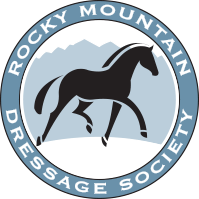The nervous system game: from the ground up
© Trudi Howley.
Society is now fueled by immediate gratification and quick fixes. Riders are not immune to this phenomenon and they typically do not generally fit well with the long path of dressage training. Many a trainer has attempted to focus and relax the student to facilitate the development of feel and connection with a tense horse. Equestrians can build a new vocabulary around their nervous system from the ground up and break down tension before they even get on a horse.
Somatic theories, meaning theories that include the body and nervous system, can help achieve performance integration. Riders can learn to become more attuned with the horse by learning simple skills towards developing their own somatic integration. Somatic or sensory integration occurs when self-defensive and protective responses to stress or even past trauma are no longer blocking energies in the body.
Sometimes basic sports psychology techniques may help a rider to relax and calm themselves but do not address the underlying causes of repetitive sports problems. Quick fixes for better training really are possible if the rider intentionally slows down, plans to optimally use brief windows of time and intentionally references their bodies. This type of somatic self-awareness complements mental approaches to riding and can be a valuable precursor to developing feel for the horse. Incorporating some basic somatic practices can provide a new way of approaching success in the saddle.
Peter Levine Ph.D., the founder of Somatic Experiencing ®, explains in his book An Unspoken Voice (2010) how the complex systems of the brains and the nervous system can be viewed like a marriage, “in either blissful harmony or in dreadful unending battle” (p.123).
Similarly, a goal in dressage can be the private or public performance of an athletically harmonious marriage between horse and rider. Many factors affect the quality of developing this type of relationship.
When on horseback, the rider responds to the horse in real time. In psychological terms, this is often called the here and now, requiring full mind and body presence in the moment. Anyone, independent of age or ability can achieve this state of awareness. Bruce Gottlieb, Licensed Clinical Social Worker, who has worked with many athletes, believes that learning from the middle of the process forward will not breed success in any sport. If a rider can knowingly bring their most integrated self to the horse then the quality of their interactions will determine the outcome of a ride rather than the number of hours in the arena.
Oftentimes it is necessary to come back to basic movements of the horse before improving advanced movements. This training premise can also be applied to a rider’s nervous system. If there is an inability to feel what is going on with the horse’s rhythm and balance at any gait, the rider can benefit by learning to settle their basic nervous system arousal or unlocking any state of freeze in their body. When these concepts become healthy habits, the nervous system can speedily reset, allowing for a more harmonious ride, and subsequently creating space in the body to know, better sense, and feel for the horse.
Freeing the rider from restrictions in the nervous system allows for a more enduring resonance with biomechanical exercises and training interventions. This leads to the development of an inner mastery that clearly senses the horse. As Lisa Baugh LMFT, therapist and equestrian recognizes, “A rider with good feel that easily flows with the horse, anticipates the horse’s moves, reactions and energy levels”. If you cannot be connected to your physical self, it is hard to be connected harmoniously to your horse.
Getting Started
If you are fortunate enough to be working with a skilled trainer, everything the trainer is telling you should have an intentional purpose. The trainer may also include goal setting and focusing techniques. So, as a rider what can you do to begin to add to these core skills from a somatic perspective?
A good place to start is choosing to invite curiosity rather than criticism about your ability to have feel for the horse. Feel is something that can be developed as a skill when not riding. Understand there is a lot of important work you can do when you are not riding. Check in with yourself, and your immediate environment whenever possible to remind yourself to be more fully present. This is a basic, achievable, goal for anyone, and can be a valuable place to start for both recreational and competitive riders.
Trudi Howley M.S., SEP, LPC, CPC is a Licensed Professional Counselor and USDF Silver Medalist. She specializes in Trauma Healing and Executive Consulting. She can be reached via transformationalsomatics.com or followed on Instagram @inscapequest

